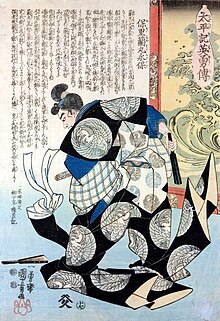This is an old revision of this page, as edited by 68.34.91.11 (talk) at 16:36, 28 April 2014 (General cleanup; tried to make the popular culture section less a list and more of actual encyclopedic relevance; will try to expand his biography later). The present address (URL) is a permanent link to this revision, which may differ significantly from the current revision.
Revision as of 16:36, 28 April 2014 by 68.34.91.11 (talk) (General cleanup; tried to make the popular culture section less a list and more of actual encyclopedic relevance; will try to expand his biography later)(diff) ← Previous revision | Latest revision (diff) | Newer revision → (diff)| This article needs additional citations for verification. Please help improve this article by adding citations to reliable sources. Unsourced material may be challenged and removed. Find sources: "Mori Ranmaru" – news · newspapers · books · scholar · JSTOR (July 2008) (Learn how and when to remove this message) |

Template:Japanese name Mori Ranmaru (森 蘭丸, 1565–June 21, 1582), born Mori Naritoshi (森 成利), was the son of Mori Yoshinari, and had 5 brothers in total, from the province of Mino. He was a member of the Mori Clan, descendants of the Seiwa Genji.
Biography
From an early age, Ranmaru was an attendant to Oda Nobunaga. Recognized for his talent and loyalty, he was appointed to a responsible post. At Ōmi, he was given 500 koku, and after Takeda Katsuyori's death, he was awarded the 50,000 koku at Iwamura Castle. Ranmaru and his younger brothers perished defending Oda Nobunaga during the Incident at Honnō-ji. Ranmaru's bravery and devotion is remembered throughout history, and especially during the Edo period because of his decision to commit seppuku and follow Nobunaga in death.
Oda and Mori's lord-vassal relationship was thought to have followed the shudo tradition, and was widely admired in Japan for its strength. In the nanshoku literature of the Edo period, it was widely understood that Oda and Mori had a sexual relationship that was commonly found in those times.
Family
- Father: Mori Yoshinari (1523-1570)
- Brothers:
- Mori Nagayoshi (1558-1584)
- Mori Tadamasa
- Mori Bōmaru (1566-1582)
- Mori Rikimaru (1567-1582)
In Popular Culture
Main article: People of the Sengoku period in popular cultureRanmaru has often been the subject of works of art since the Edo period, and continues to be seen in various forms of modern fictional media today. Due to admiration for his loyalty, Ranmaru has been depicted as a loyal page of Nobunaga in various works of classical Japanese art. Such works include ukiyo-e prints by artists such as Kuniyoshi, Yoshitoshi, and Toshihide. He has also been a character in kabuki plays such as Tsuruya Namboku IV's Toki-ha Ima Kikyô no Hataage .
In most modern media his portrayal as a loyal servant to Nobunaga is continued. This can be seen in historical drama films and television programs such as Akira Kurosawa's Kagemusha and various Taiga dramas, in novels such as Eiji Yoshikawa's Taiko, in manga such as Hyouge Mono and A Chef of Nobunaga, and in video games such as Samurai Warriors, Sengoku Basara, and Pokemon Conquest. He is occasionally portrayed as a woman as seen in the stage play and anime series Nobunaga the Fool and the tokusatsu series Kamen Rider Gaim. Ranmaru has also been the subject of modern music, such as KAT-TUN's 1582 which is written from the perspective of Mori Ranmaru at the Incident at Honnouji.
See also
![]() Media related to Mori Ranmaru at Wikimedia Commons
Media related to Mori Ranmaru at Wikimedia Commons
Notes
- Ota Gyuichi. The Chronicle of Lord Nobunaga. Brill Academic Press (2011). ISBN 9004201629 Page 311
- Edward Carpenter, Intermediate Types among Primitive Folk pp140-150
- "Personalities such as Oda Nobunaga's boy lover Mori Ranmaru were widely known throughout the Edo period." Timon Screech, Sex and the floating world: erotic images in Japan, 1700-1820 - Page 84
- Badarai no Mitsuhide
- English Translation and Backstory of the song 1582
References
- Ota Gyuichi. The Chronicle of Lord Nobunaga. Brill Academic Press (2011). ISBN 9004201629